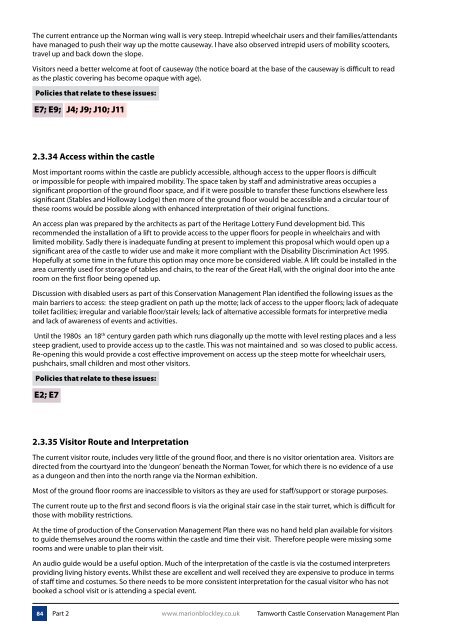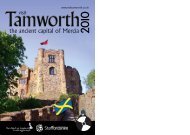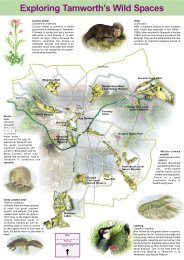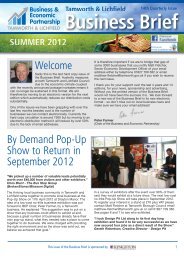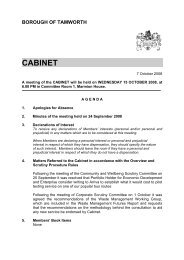Conservation Management Plan - Tamworth Borough Council
Conservation Management Plan - Tamworth Borough Council
Conservation Management Plan - Tamworth Borough Council
You also want an ePaper? Increase the reach of your titles
YUMPU automatically turns print PDFs into web optimized ePapers that Google loves.
The current entrance up the Norman wing wall is very steep. Intrepid wheelchair users and their families/attendants<br />
have managed to push their way up the motte causeway. I have also observed intrepid users of mobility scooters,<br />
travel up and back down the slope.<br />
Visitors need a better welcome at foot of causeway (the notice board at the base of the causeway is difficult to read<br />
as the plastic covering has become opaque with age).<br />
Policies that relate to these issues:<br />
E7; E9; J4; J9; J10; J11<br />
2.3.34 Access within the castle<br />
Most important rooms within the castle are publicly accessible, although access to the upper floors is difficult<br />
or impossible for people with impaired mobility. The space taken by staff and administrative areas occupies a<br />
significant proportion of the ground floor space, and if it were possible to transfer these functions elsewhere less<br />
significant (Stables and Holloway Lodge) then more of the ground floor would be accessible and a circular tour of<br />
these rooms would be possible along with enhanced interpretation of their original functions.<br />
An access plan was prepared by the architects as part of the Heritage Lottery Fund development bid. This<br />
recommended the installation of a lift to provide access to the upper floors for people in wheelchairs and with<br />
limited mobility. Sadly there is inadequate funding at present to implement this proposal which would open up a<br />
significant area of the castle to wider use and make it more compliant with the Disability Discrimination Act 1995.<br />
Hopefully at some time in the future this option may once more be considered viable. A lift could be installed in the<br />
area currently used for storage of tables and chairs, to the rear of the Great Hall, with the original door into the ante<br />
room on the first floor being opened up.<br />
Discussion with disabled users as part of this <strong>Conservation</strong> <strong>Management</strong> <strong>Plan</strong> identified the following issues as the<br />
main barriers to access: the steep gradient on path up the motte; lack of access to the upper floors; lack of adequate<br />
toilet facilities; irregular and variable floor/stair levels; lack of alternative accessible formats for interpretive media<br />
and lack of awareness of events and activities.<br />
Until the 1980s an 18 th century garden path which runs diagonally up the motte with level resting places and a less<br />
steep gradient, used to provide access up to the castle. This was not maintained and so was closed to public access.<br />
Re-opening this would provide a cost effective improvement on access up the steep motte for wheelchair users,<br />
pushchairs, small children and most other visitors.<br />
Policies that relate to these issues:<br />
E2; E7<br />
2.3.35 Visitor Route and Interpretation<br />
The current visitor route, includes very little of the ground floor, and there is no visitor orientation area. Visitors are<br />
directed from the courtyard into the ‘dungeon’ beneath the Norman Tower, for which there is no evidence of a use<br />
as a dungeon and then into the north range via the Norman exhibition.<br />
Most of the ground floor rooms are inaccessible to visitors as they are used for staff/support or storage purposes.<br />
The current route up to the first and second floors is via the original stair case in the stair turret, which is difficult for<br />
those with mobility restrictions.<br />
At the time of production of the <strong>Conservation</strong> <strong>Management</strong> <strong>Plan</strong> there was no hand held plan available for visitors<br />
to guide themselves around the rooms within the castle and time their visit. Therefore people were missing some<br />
rooms and were unable to plan their visit.<br />
An audio guide would be a useful option. Much of the interpretation of the castle is via the costumed interpreters<br />
providing living history events. Whilst these are excellent and well received they are expensive to produce in terms<br />
of staff time and costumes. So there needs to be more consistent interpretation for the casual visitor who has not<br />
booked a school visit or is attending a special event.<br />
84 Part 2 www.marionblockley.co.uk <strong>Tamworth</strong> Castle <strong>Conservation</strong> <strong>Management</strong> <strong>Plan</strong>


